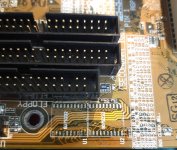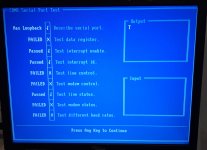Chr$
Experienced Member
I wonder if anyone has experienced this before. I have an ASUS P5A-B Super Socket 7 Motherboard. It was happily running Win 98 the other day when all of a sudden the serial mouse stopped working. I restarted and got the 'no mouse detected message'. Tried another mouse, same thing. Tried removing com ports, reinstalling etc and nothing worked (although USB mice do work fine). Since then I've also tried a different PSU.
For sanity I checked both the mice on my IBM XT and neither of them work now, and they were absolutely fine before!
So I got out the multimeter and checked the serial port - with one lead on a good ground and with the PC on I measure -12v on pins 2, 4 and 7. In continuity mode those 3 pins also show 0 ohm shorts whereas pin 3 (which should be gnd) shows about 10 ohms to ground. With the computer off, pin 3 is 0 ohm to gnd, as it should be. I suppose -12v where it shouldn't go to has killed the 2 mice. Serial port 2 is the same, with -12v on pins 2, 4 and 7 when the PC is on.
What on earth is going on? The serial port chips on the m/b are a pair of Holtek HT6751.
I've disassembled one of the mice and it's mostly passives with a Motorola LXC437159P chip. To get that mouse working again is it worth obtaining and fitting a new LXC437159P?
For sanity I checked both the mice on my IBM XT and neither of them work now, and they were absolutely fine before!
So I got out the multimeter and checked the serial port - with one lead on a good ground and with the PC on I measure -12v on pins 2, 4 and 7. In continuity mode those 3 pins also show 0 ohm shorts whereas pin 3 (which should be gnd) shows about 10 ohms to ground. With the computer off, pin 3 is 0 ohm to gnd, as it should be. I suppose -12v where it shouldn't go to has killed the 2 mice. Serial port 2 is the same, with -12v on pins 2, 4 and 7 when the PC is on.
What on earth is going on? The serial port chips on the m/b are a pair of Holtek HT6751.
I've disassembled one of the mice and it's mostly passives with a Motorola LXC437159P chip. To get that mouse working again is it worth obtaining and fitting a new LXC437159P?


